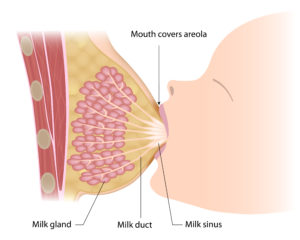A successful breastfeeding means that your baby gets the most out of the breast milk you produce. This can be achieved through proper latching. This breastfeeding latch position guide gives you a comprehensive description of the best breastfeeding position to successfully latch your baby.
In order to secure a good breastfeeding relationship, you want your latch to be both comfortable and effective.

First, let’s explore breastfeeding positions. A good, comfortable position will promote an optimal latch for your baby. Consider the following:
1- Football Hold
Place your baby by your side, face up, and supported by a breastfeeding pillow. We recommend the My Brest Friend because it is much more comfortable and versatile for moms than the Boppy. This position is great for beginners and women with larger breasts.
2- Cradle and Cross Cradle
With the cradle hold, your baby lies lengthwise across your abdominal area, resting his or her head on your elbow while your hand supports the backside and bottom area. With the cross cradle, your baby is lying on his or her side facing you. Both of these holds are ideal with nursing pillows and are great for both younger and older babies.
3- Side Lying Position

This is when a mom lays on her side, with the baby laying on his or her side facing the mom. You are chest to chest, with your arm supporting your baby’s body. This popular hold is great for night feedings.
Now that we’ve discussed some popular breastfeeding positions, we will explore the latch, itself. Your baby’s chin should touch the bottom of the nipple before the baby brings his or her entire mouth over it. You want to bring the baby to the breast, not the breast to the baby – this ensures optimal comfort and positioning, decreasing the risk of neck and shoulder aches. With your baby’s head securely held in one hand, bring his chin up to the bottom of your nipple, keeping his nose in line with it. Your baby should respond by dropping his lower jaw – the baby then uses his tongue to take in a large mouthful of your breast. Your nipple should be at the back of your baby’s mouth, which will allow optimal positioning to remove milk from your ducts. Remember, you want to aim your nipple toward your baby’s upper lip and nose, not his mouth.
Take a good look at your baby when he or she is latched on and look for these key things:
- Top and bottom lips are flanged out like a fish, with a visible top lip crease
- Chin is touching your breast, nose is free Your baby’s eating pattern changes from short, quick sucks to deep sucks
- Cheeks are full and rounded during the feed
- Baby is relaxed and isn’t wiggling during the feed
- The lower portion of your areola is in the baby’s mouth as much as possible If you’re having issues attaining a proper latch, it’s always best to speak directly with an IBCLC.
- Breastfeeding can be a little uncomfortable as you get the hang of it, but it shouldn’t hurt.

If you’re worried that your baby isn’t getting enough milk, a good indication is the number of wet and dirty diapers your baby is having. Once your milk comes in, you should be changing 5-6+ wet diapers every 24 hours. Babies typically have 3-4 stools a day, with the breastfed baby having seedy, mustard yellow stools. However, it is normal for a breastfed baby to go several days without having a bowel movement, as long as he or she isn’t showing any signs of discomfort. It’s always important to look for your baby’s hunger cues, such as rooting, when you begin feeding. If you wait until she is hungry, it is going to be more frustrating for both of you and less likely that she will have the proper latch. Are your nipple and areola in your baby’s mouth? If not, you will need to pop her off and readjust her. Sometimes improper positioning can also result in a poor latch. Make sure you’re practicing the above positions and getting yourself and your baby as comfortable as possible before beginning your nursing session. Feel free to use rolled up towels or blankets to help you position your breasts or your baby, as needed.
One of the most common complaints from new moms is of sore nipples. If your nipples are cracked or bleeding, this could be due to an improper latch. To avoid sore nipples, make sure to dry them thoroughly after every feed and apply a soothing nipple cream. Many moms love Lanolin, Motherlove, or the Honest Company’s brand, but use the one that best fits your needs. Make sure to wear breast pads and change them often, as well as a comfortable and supportive bra. Consistently sore, cracked, or bleeding nipples can be a symptom of a tongue-tie in your baby and is sometimes a reason for a poor latch or decreased milk transfer. If you suspect that your baby could have a tongue-tie, please see an experienced IBCLC to discuss a referral to a preferred provider for evaluation. The revision is a very straightforward procedure that can help tremendously with your baby’s latch and breastfeeding success. Just like with anything, breastfeeding gets better with practice. Don’t feel discouraged if you’re having trouble getting your baby to latch properly you are not alone! Try these tips and make sure to contact a certified lactation consultant when needed.
Was there a particular position that worked best for you, side lying is so natural and beneficial for both mom and baby, most new moms experience some nipple pain at the begging, how did you deal with it?






